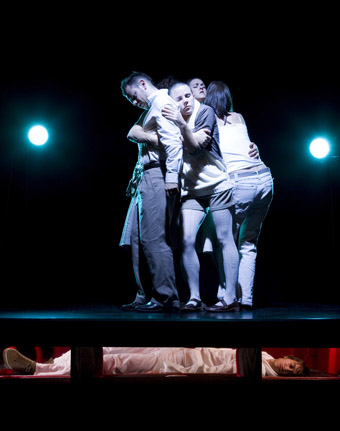The ambiguities of being
Philipa Rothfield

Chunky Move, Singularity
photo Chris Budgeon
Chunky Move, Singularity
Chunky Move: Singularity
We enter a cavern, large, deep and dark, filled with 6 enormous squares. Some are like small stages, others large cots. Each contains a person. As we mill expectantly, a young woman screeches, asthmatic animal breathing, pacing her square in choreographed lunges and pelvic thrusts. Her sexuality repulses. A man in a suit stammers his way through a series of micro-movements, clever clockwork. He is shy and inadequate. Each square in turn gives way to the repeated performance of a solipsistic mantra. A young woman falls backwards again and again; a man moves sections of his body as if they were separate, independent of the whole. Quiet violence erupts. The audience swarms around the action, and then drifts away.
Dysfunctional is too weak a word, too close to functional. This work attempts to depict that which is beyond sanity. But for the hysterical breathing, the madness presented here was almost aesthetic, the 6 performers assuming the shape of insanity rather than its lived experience.
The large squares move, slowly joining, bringing our introverts into contact with each other. How would these introverts interact? Some patterns were inhibited, others augmented. When this gave way to the group it was somewhat disappointing. Perhaps a group of such individuals was bound to amount to little, a slow decline towards the entropy of the floor.
One of the strongest aspects of Singularity was its reinsertion of each individual into some context of the everyday, whether in lifts, at a party or on public transport. These moving tableaux were wonderful, adding the social, the normal, to that which is not. My favourite section was a party scene that alternated between bubbling interaction (normal state) and complete exclusion (the girl’s perception of an evacuated humanity). A girl, radically alone, at a party full of people. This was stunning, scary, like the vision of a psychopath. It would have been great if all the everyday settings were likewise elaborated to contrast the individual’s experience with the social norms of everyday life.
Some parts of Singularity worked better than others, some bits could have been cut, and others developed more physically and emotionally. However, its general thrust, to represent and recontextualise pathological forms of experience, had real integrity.
Kage: Headlock
In the absence of dialogue physical theatres can sometimes look odd in their mute reinterpretation of everyday life. In depicting a primarily physical relationship between brothers, Headlock evoked a fairly realistic field of action, barely announcing itself as physical theatre. Three boys hang out, playing their favourite fantasy of championship wrestling, sometimes literally, sometimes through sibling rivalries. Competition borders on aggression. Each boy has a distinct personality, always framed in relation to the others. One boy, Matthew, is deaf. The others protect and taunt him in turns. We come to realise that these are memories, that time has intruded upon childhood. Another brother, the eldest, has died—we don’t know how exactly, though we know he was the ringleader. Perhaps he skated too close to danger. Perhaps his fearlessness turned to self-destruction. In any case, there are now only 2 boys, one of them going to prison.
Headlock was measured in terms of a single night, Shane’s first in prison. It moved imperceptibly slowly, signalled by a digital clock looming larger than Melbourne’s landmark Nylex clock. Time does not flow here. It jumps, then freezes. Shane’s despair is softened through the intercession of flashbacks and the appearance of his dead brother offering advice, provoking memories. To what extent did memories help Shane survive prison life? Or was memory a means of escape? Headlock created a strong contrast between the trio of siblings as an ensemble and the isolation of adulthood. The status of Shane’s memories is thus ambiguous.
The strength of Headlock lies in the relation between the 3 boys and in its stark contrast with the reality of prison life. The physical nuances of their play established the jouissance of their relationship. I watched Headlock with an audience of school children. Their attention reciprocated the action onstage; they understood the sheer stuffing around, killing time of childhood.
Headlock raises issues of childhood and danger, play and destruction, aggression and love. Its exploration in a largely physical domain worked very well where class disadvantage vies with the creativity of children in the generation of 3 life histories.
–
Body Corporate:Chunky Move, Singularity, choreographer-director Gideon Obarzanek, performers Kristy Ayre, Antony Hamilton, Paea Leach, Kirstie McCracken, Carlee Mellow, Lee Serle, designer Dirk Zimmerman, sound, Darrin Verhagen, lighting, Niklas Pajanti; Arts House, North Melbourne Town Hall, May 12-28
Kage Physical Theatre, Headlock, director Kate Denborough, performers Luke Hockley, Byron Perry, Gerard Van Dyck, text David Denborough, design Ben Cobham, Andrew Livingstone (Bluebottle); Malthouse Theatre, Melbourne, May 18-June 3
RealTime issue #74 Aug-Sept 2006 pg. 34






